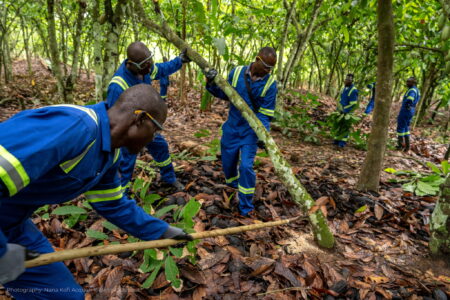Exclusive: Cocoa prices hit fresh stock exchange highs, as pressure on global markets continues

pic: Shutterstock
Cocoa prices on the New York and London stock exchanges have continued to surge on the advanced purchasing futures markets, rising to over $6,400 a tonne this week, amid reports of hedge fund betting fuelling rates further, writes Neill Barston.
According to a Financial Times investigation this month, a total of $8,7 billion has been poured into the two key British and US trading platforms, representing an unprecedented sum, as the sector’s key production players in Ghana and Ivory Coast, representing 70% of supplies, experience crop deficits attributed to extreme weather conditions, diseases affecting cocoa plantations, as well as other key geopolitical supply chain challenges.

Advanced prices on cocoa stock markets have reached over $6,400 a tonne this week. Pic: Bloomberg
Global financial media reports this month have portrayed what has been phrased as a ’46 year high for prices’ on the stock exchanges, as rates sped past the $5,000 a tonne mark, which was last seen in 1977 – though these direct comparisons do not account for inflation. The sum seen in the 1970s, would now be worth the equivalent of $28,000 a tonne.
But the situation is, that while in reality, not an actual real-terms price high, the cost of cocoa has literally doubled from what it was a year ago, raising alarm from many leading confectionery brands including Lindt, Mondelez and Hershey, noting significant market disruption in their annual reporting.
As UK ingredients business Henley Bridge recently explained to Confectionery Production, pressure on the commodities markets had been intensified due to a number of factors including increased demand for premium chocolate from countries including India and China. The business also noted a complete reverse in cost trends, stating that whereas once milk and white chocolate were previously cheaper than dark chocolate, dark varieties are now fetching the same or higher prices.
The business asserted that chocolate prices would remain high this year in light of the rise in cocoa costs – which have doubled in the space of the year. The company’s commercial director, Steve Calver, forecast that prices could drop moving into 2025/6. “Due to the high cost of real chocolate, some markets may go back to using imitation chocolate which would, in turn, reduce demand, but that’s just pure speculation at this stage.”
Speculators payday not felt by farmers
While cocoa prices have been exceptionally bullish in the last year compared to recent performance, many industry observers in core West African markets have noted that this has not filtered down to farming communities in Ghana and Ivory Coast.
As Confectionery Production reported last October, farmers did in fact gain a 11% pay rise in Ivory Coast in light of rising commodity prices, but this is far less than many had expected, and did little to impact their standards of living given that many are still working on less than $1 a day, well below UN defined poverty level wages.
The picture in Ghana, which commands a higher rate for its cocoa, which is generally considered to be of a more premium grade, farmers gained a 63% rise, which was met with positivity by communities in the region, but with prices continuing to soar within the past five months, there has been no further reported wider adjustment of wages for farmers.
This subject formed part of discussions at this year’s Chocoa and World Cocoa Foundation partnership meeting conversations in Amsterdam earlier this month, and is set to come under the microscope again in April, at the World Cocoa Conference in Brussels, which has placed achieving sustainable cocoa production through raising agricultural pay at the heart of its agenda.



